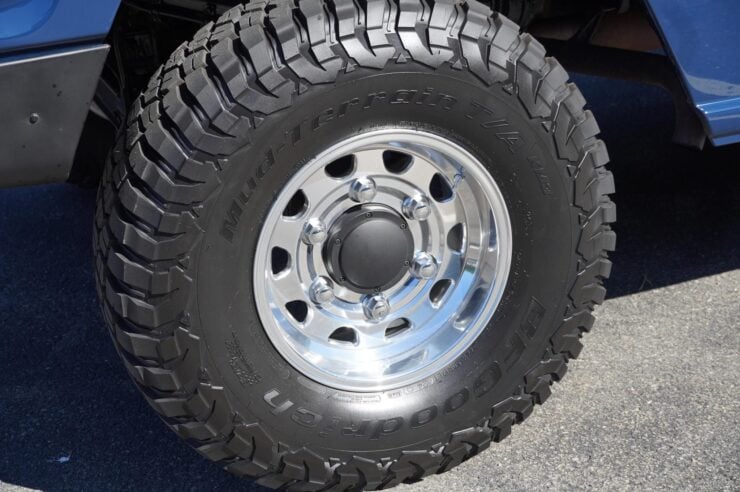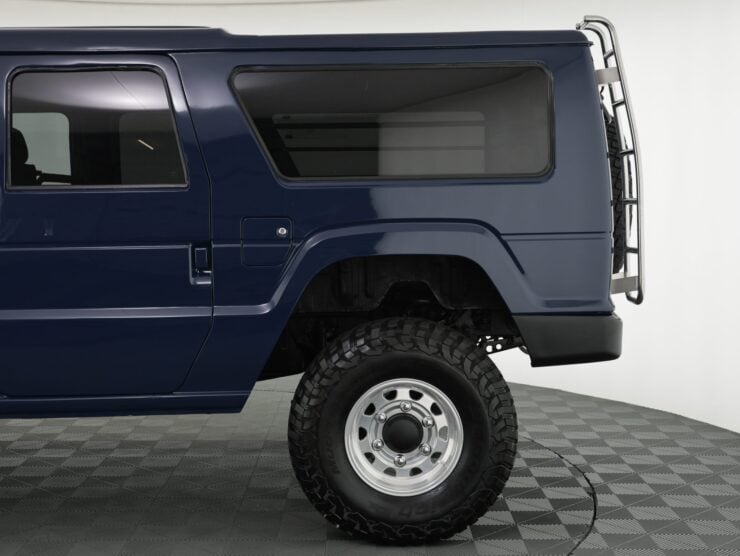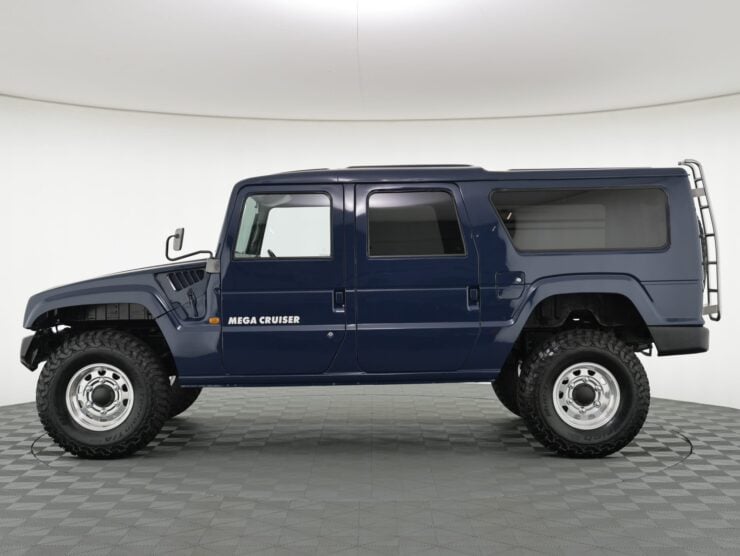This is a 1997 Toyota Mega Cruiser, at first glance many mistake it for a Humvee and that’s completely understandable as Toyota took a hefty dose of inspiration from the American military 4×4 during the development of the Mega Cruiser.
The name Mega Cruiser was chosen as it directly linked the vehicle to the Land Cruiser family of 4x4s, a series that had been in production since 1951. Interestingly, the earliest Toyota 4x4s took their inspiration from another American off-roader – the WWII-era Willys Jeep.
Fast Facts – The Toyota Mega Cruiser
- The 1997 Toyota Mega Cruiser, often mistaken for a Humvee, was directly inspired by the American military vehicle. Initially designed for military use, it entered production in 1995 and was sold mostly to the Japan Self-Defense Forces, police, and rescue units, with only 133 units sold to civilians.
- The Mega Cruiser featured body-on-frame construction, independent suspension with portal axles, and a 4.1-liter turbodiesel engine producing 153 bhp. It also had four-wheel steering, front, center, and rear locking differentials, and an optional central tire pressure system – making it highly capable off-road.
- Despite its military and municipal success, civilian sales were low due to Japan’s tax structure, narrow streets, and fuel costs. In total, 3,000 units were produced before production ended in 2001. The Mega Cruiser would also serve as a testbed for innovations later used in the Land Cruiser series.
- This 1997 Toyota Mega Cruiser, originally built for civilian use, has just 36,000 kilometers (22,000 miles) on the odometer. It features blue paint, gray cloth upholstery, and modern amenities like air conditioning and a CD stereo. It’s currently for sale in Hudson, New Hampshire with a clean title.
A History Speedrun: The Toyota Mega Cruiser
The Toyota Mega Cruiser was developed initially for military use, to fill a role almost identical to that of the American Humvee. It was first shown to the public in 1993 at the Tokyo Motor Show, it then entered series production in 1995.


The Mega Cruiser could be bought at Toyota Store locations, however almost all buyers were either the Japan Self Defense Forces, or prefectural police, fire and rescue departments, or the Japan Auto Federation. Just 133 examples were sold to civilians.
There are a number of reasons for the low number of civilian sales, Japan’s tax structure makes large vehicles economically unviable for most, Japanese streets are often much smaller and more narrow than their American counterparts, and the cost of fuel can be prohibitive.
In its military and municipal roles the Mega Cruiser proved useful, 3,000 were sold in total before production was ended in 2001. The reason given for the end of production was that sales were low, however Toyota had also been using the Mega Cruiser as a testbed for concepts that may have been useful for the Land Cruiser series.
The Toyota Mega Cruiser: Specifications
The Toyota Mega Cruiser has body-on-chassis construction with independent front and rear suspension with double wishbones, and portal axles, offering improved ground clearance due to the lack of a low-slung differential as with live axle 4x4s.
Power is provided by a front-mounted 4.1 liter turbodiesel inline-four producing 153 bhp and 282 lb ft of torque. This was considerably smaller than the engine options used in the Humvee but it did offer decent fuel economy for the heft of the vehicle – tipping the scales at 2,850 kgs (6,283 lbs).
Power is sent back through a 4-speed Aisin A443F automatic transmission which is mated to a dual-range transfer case. Unusually, the Mega Cruiser has four wheel steering, allowing it to be more maneuverable in tight spaces, and it has front, center, and rear differential locks.
There was a central tire pressure system offered as an option, though it’s not known how many came equipped with it. There is seating for two people up front and four in the back, and it has four doors plus a door on the rear to access the cargo compartment.
There were soft top versions created for the military, as well as the BXD10 version which had a rear-mounted Type 93 Surface-to-air missile produced by Toshiba Heavy Industries. The military Humvee was officially called the High Mobility Multipurpose Wheeled Vehicle (or HMMWV), whereas the military version of the Mega Cruiser was officially named the High Mobility Vehicle (or HMV).
Many examples of the Mega Cruiser have now been exported out of Japan and into other nations, with the United States being the largest market for these gray market imports.
The 1997 Toyota Mega Cruiser Shown Here
The 1997 Toyota Mega Cruiser is one of the examples that was originally designed and built for civilian use. It has just 36,000 kilometers (~22,000 miles) on the odometer, and it was imported into the United States in July of this year.
It’s finished in blue over gray cloth upholstery, with 17″ alloy wheels, air conditioning, a CD stereo, a swing-away spare tire carrier, a rear ladder, and those distinctive triple front windshield wipers.
The good news is that this Mega Cruiser is now being offered for sale on Bring a Trailer out of Hudson, New Hampshire with a clean New Hampshire title. If you’d like to read more about it or register to bid you can visit the listing here.























Images courtesy of Bring a Trailer










